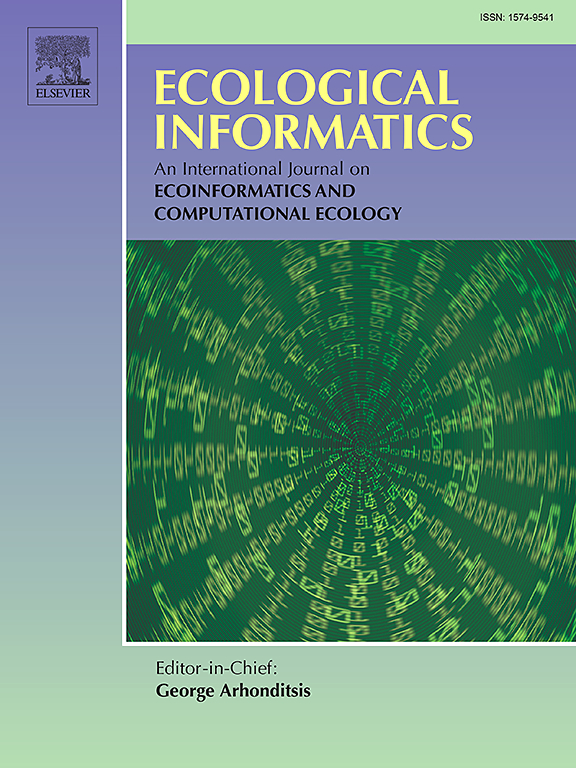Locating and profiling city street trees using Baidu street view images for carbon storage evaluation
IF 7.3
2区 环境科学与生态学
Q1 ECOLOGY
引用次数: 0
Abstract
Traditional methods for estimating the carbon storage of street trees involve manual sampling, which incurs substantial human, material, and temporal costs in establishing a city-wide comprehensive inventory of street trees. In this study, we propose a multi-task convolutional neural network called STV-MNet to identify individual- level and city-wide street trees from Baidu street view images (BSVIs). We measured the structural and locational information of the identified trees using cylindrical projection and MonoDepth depth estimation network. STV-MNet achieved a mean intersection over union (mIoU) of 0.733 and a mean average precision of 0.881 at IoU 50 % (mAP50) in individual tree identification, outperforming DeepLab v3+ (mIoU of 0.641) and YOLO v3 (mAP50 of 0.767). Validation with street-measured data demonstrates that our method produces more precise estimations for both tree height and breast diameter, with the root mean square error (RMSE) of 0.09 m and the normalized RMSE of 0.005 m for tree height and the RMSE of 0.01 m and the normalized RMSE of 0.016 m for diameter at breast height (DBH). The location prediction of street trees achieves a minimum error of 0.67 m and an average error of 7.37 m. Using the biomass carbon storage equation, we calculated the carbon storage of individual street trees in Changsha City, Hunan Province, China. The results indicate that the total carbon storage of 333,717 street trees in urban areas of Changsha City is 1.64 × 105 tons, and the annual carbon sequestration capacity across the urban areas is 8014.57 tons. In certain areas, street tree resources have enabled the achievement of carbon neutrality in road transportation. This study presents a novel approach to managing urban street tree carbon storage, leveraging STV-MNet for automatic carbon storage estimates, and demonstrates high practical significance in low-cost and city-wide street tree carbon storage estimation.
利用百度街景图像定位和分析城市行道树的碳储量评估
估算行道树碳储量的传统方法涉及人工采样,在建立全市范围的行道树综合清单时,会产生大量的人力、物力和时间成本。在这项研究中,我们提出了一种称为STV-MNet的多任务卷积神经网络,用于从百度街景图像(BSVIs)中识别个人级别和城市范围的街道树。我们使用圆柱投影和MonoDepth深度估计网络测量被识别树木的结构和位置信息。在单株树识别中,STV-MNet的平均交联度(mIoU)为0.733,平均平均精度(mAP50)为0.881,优于DeepLab v3+ (mIoU为0.641)和YOLO v3 (mAP50为0.767)。街道实测数据验证表明,我们的方法对树高和胸径的估计更加精确,树高的均方根误差(RMSE)为0.09 m,归一化RMSE为0.005 m,胸径(DBH)的均方根误差(RMSE)为0.01 m,归一化RMSE为0.016 m。行道树位置预测的最小误差为0.67 m,平均误差为7.37 m。利用生物量碳储量方程,对长沙市行道树单株碳储量进行了计算。结果表明:长沙市城区33万3717棵行道树的总碳储量为1.64 × 105 t,城区年固碳能力为8014.57 t;在某些地区,街道树木资源使道路运输实现了碳中和。本研究提出了一种新的城市街道树木碳储量管理方法,利用STV-MNet进行自动碳储量估算,在低成本、全城市范围的街道树木碳储量估算中具有重要的现实意义。
本文章由计算机程序翻译,如有差异,请以英文原文为准。
求助全文
约1分钟内获得全文
求助全文
来源期刊

Ecological Informatics
环境科学-生态学
CiteScore
8.30
自引率
11.80%
发文量
346
审稿时长
46 days
期刊介绍:
The journal Ecological Informatics is devoted to the publication of high quality, peer-reviewed articles on all aspects of computational ecology, data science and biogeography. The scope of the journal takes into account the data-intensive nature of ecology, the growing capacity of information technology to access, harness and leverage complex data as well as the critical need for informing sustainable management in view of global environmental and climate change.
The nature of the journal is interdisciplinary at the crossover between ecology and informatics. It focuses on novel concepts and techniques for image- and genome-based monitoring and interpretation, sensor- and multimedia-based data acquisition, internet-based data archiving and sharing, data assimilation, modelling and prediction of ecological data.
 求助内容:
求助内容: 应助结果提醒方式:
应助结果提醒方式:


